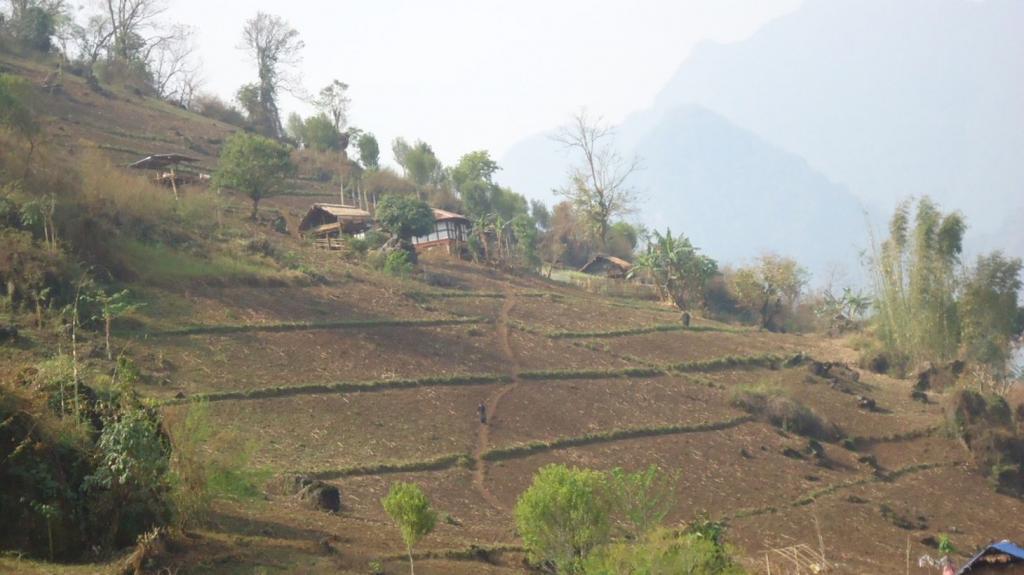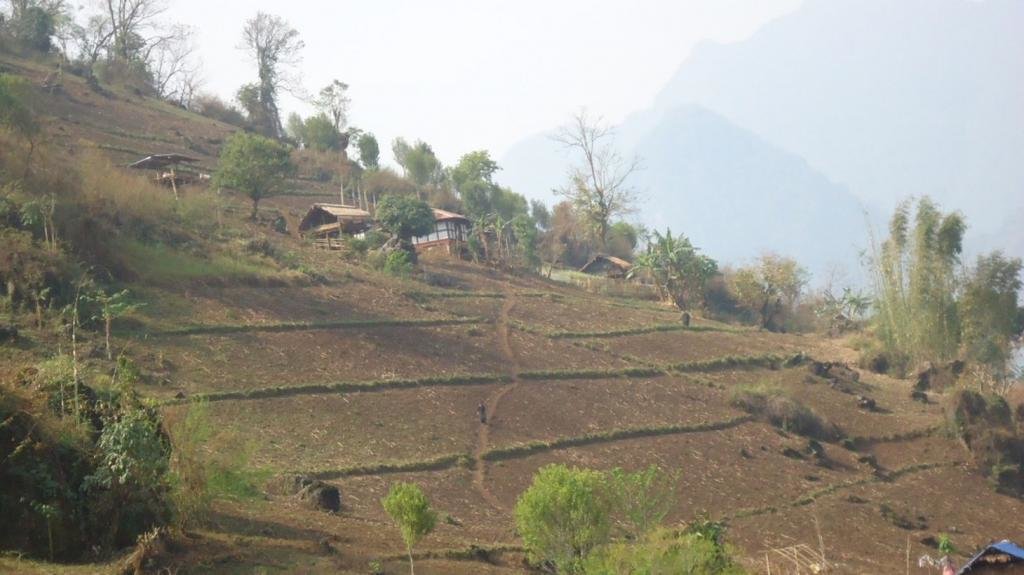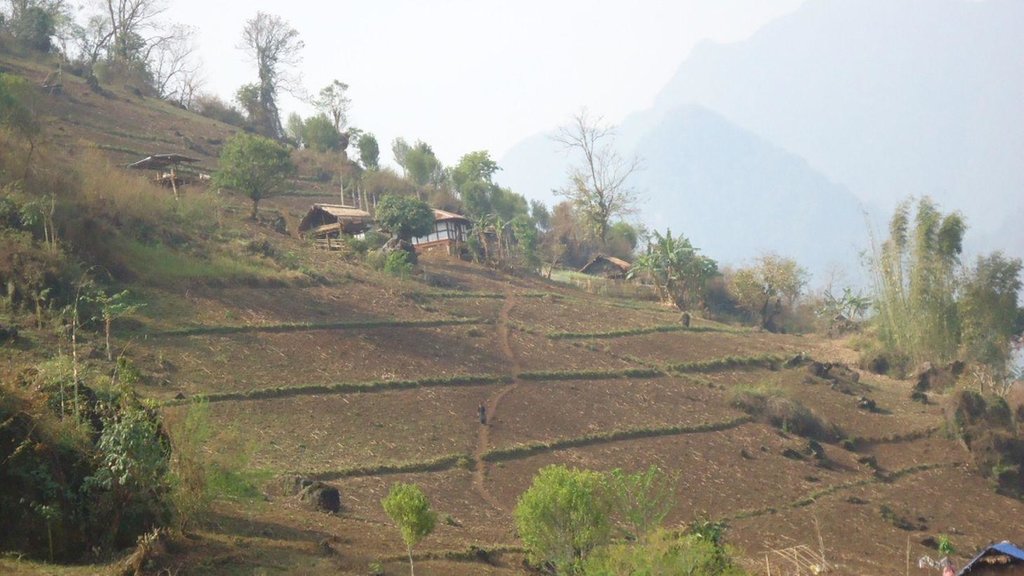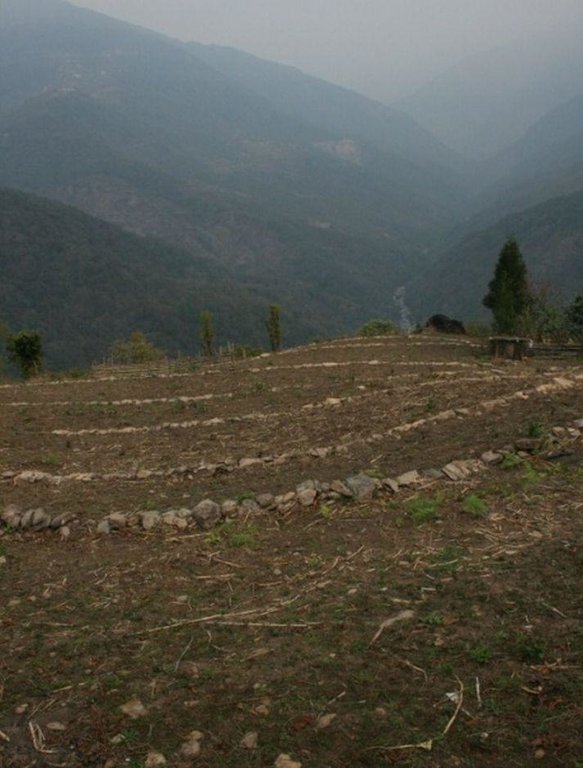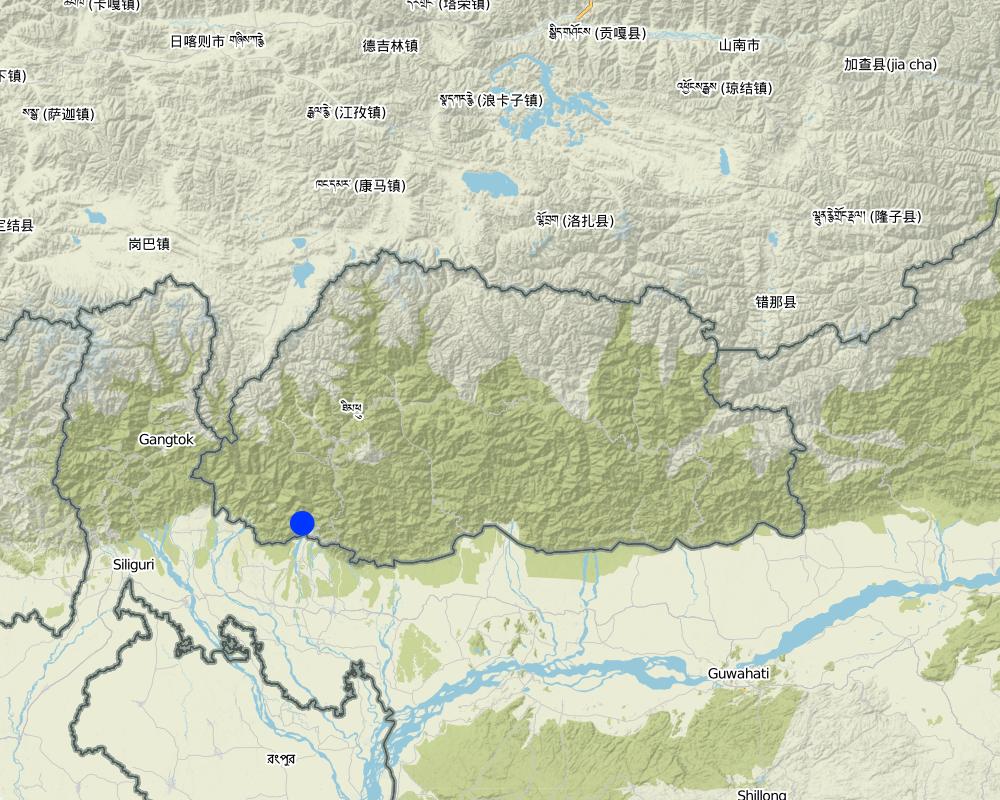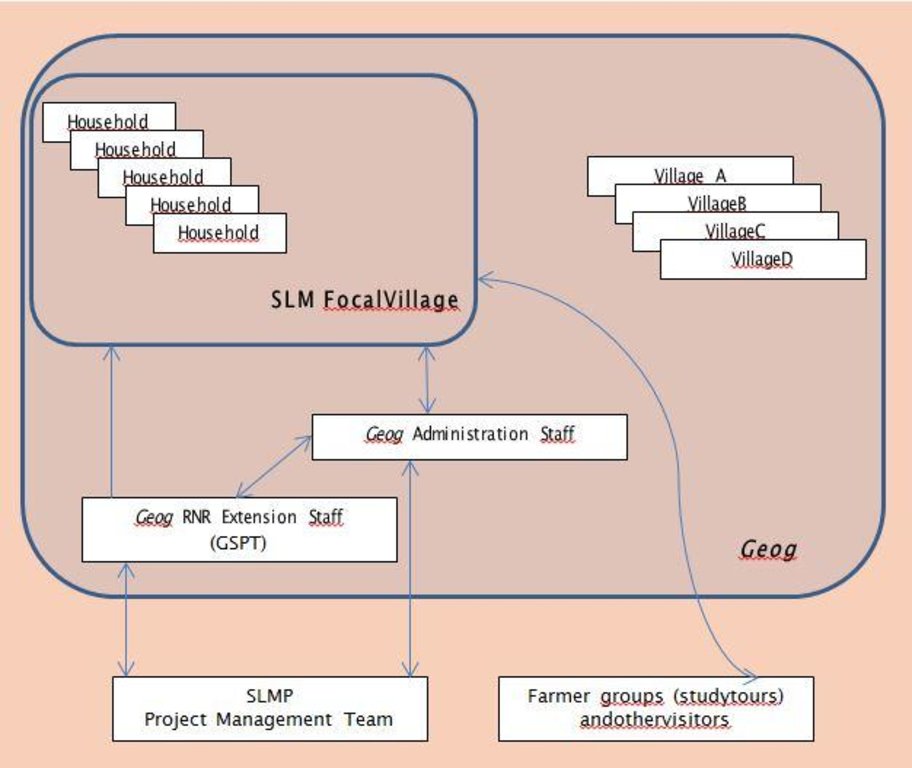SLM Focal Village [ប្រទេសប៊ូតង់]
- ការបង្កើត៖
- បច្ចុប្បន្នភាព
- អ្នកចងក្រង៖ Karma Dorji
- អ្នកកែសម្រួល៖ –
- អ្នកត្រួតពិនិត្យ Fabian Ottiger
approaches_2490 - ប្រទេសប៊ូតង់
ពិនិត្យមើលគ្រប់ផ្នែក
ពង្រីកមើលទាំងអស់ បង្រួមទាំងអស់1. ព័ត៌មានទូទៅ
1.2 ព័ត៌មានលម្អិតពីបុគ្គលសំខាន់ៗ និងស្ថាប័នដែលចូលរួមក្នុងការវាយតម្លៃ និងចងក្រងឯកសារនៃវិធីសាស្ត្រផ្សព្វផ្សាយ
ឈ្មោះអង្គភាពមួយ (ច្រើន) ដែលបានចងក្រងឯកសារ/ វាយតម្លៃលើវិធីសាស្ត្រផ្សព្វផ្សាយ (បើទាក់ទង)
MoA (MoA) - ប្រទេសប៊ូតង់ឈ្មោះអង្គភាពមួយ (ច្រើន) ដែលបានចងក្រងឯកសារ/ វាយតម្លៃលើវិធីសាស្ត្រផ្សព្វផ្សាយ (បើទាក់ទង)
National Soil Services Centre (National Soil Services Centre) - ប្រទេសប៊ូតង់1.3 លក្ខខណ្ឌទាក់ទងទៅនឹងការប្រើប្រាស់ទិន្នន័យដែលបានចងក្រងតាមរយៈវ៉ូខេត
តើពេលណាដែលទិន្នន័យបានចងក្រង (នៅទីវាល)?
20/03/2011
អ្នកចងក្រង និង(បុគ្គលសំខាន់ៗ)យល់ព្រមទទួលយកនូវលក្ខខណ្ឌនានាទាក់ទងទៅនឹងការប្រើប្រាស់ទិន្នន័យដែលបានចងក្រងតាមរយៈ វ៉ូខេត:
បាទ/ចា៎
1.4 ការយោងមួយ (ច្រើន) ទៅលើ (កម្រង) បញ្ជីសំណួរនៃបច្ចេកទេស SLM
2. ការពណ៌នាអំពីវិធីសាស្ត្រផ្សព្វផ្សាយ SLM
2.1 ពណ៌នាសង្ខេបខ្លីពីវិធីសាស្ត្រផ្សព្វផ្សាយ
Focused support to a single village community to promote the widespread integrated implementation of SLM interventions.
2.2 ពណ៌នាលម្អិតពិវិធីសាស្ត្រផ្សព្វផ្សាយ
ពណ៌នាលម្អិតពិវិធីសាស្ត្រផ្សព្វផ្សាយ:
Aims / objectives: A SLM Focal Village is an approach to focus support to a particular village where a whole range of integrated SLM interventions is showcased in order to create visual impact and to serve as a demonstration site. The concept of a SLM Focal Village was developed in order to tackle the concern of dilution of impact caused by inclusion of all the villages and the households that are geographically very scattered and dispersed. Focal villages are selected at geog (block) level based on their accessibility, visibility for visitors and passers-by, severity of land degradation issues and interest shown by the village community.
Methods: Participatory SLM Action Planning is used to identify land-based problems, their causes and to discuss, select and prioritize specific targeted SLM interventions into a chiog (village) SLM action plan. Additional support is given to the village community to convert larger complexes of clustered land to more sustainable use with locally suited SLM practices. Popular interventions are stone bunding, grass hedgerows, bench terracing, bamboo and tree plantation and fodder development. The for-mation of labour-sharing groups is promoted in the SLM Focal Villages to ease high labour requirement for some SLM activities.
Stages of implementation: Where possible, integrated approaches are adopted, linking increasing vegetative cover of degraded or vulnerable areas with fodder development in marginal slope segments. FYM shed construction is combined with breed improvement and transition to stall feeding, providing manure for cropland. The SLM Focal Villages are used as demonstration sites and interested farmer groups on study tours and other visitors can get a quick impression of a variety of SLM activities showcased in a limited geographical area.
Role of stakeholders: The SLM Focal Villages are used as demonstration sites and interested farmer groups on study tours and other visitors can get a quick impression of a variety of SLM activities showcased in a limited geographical area.
Other important information: SLM Focal Villages require more guidance and monitoring by local extension staff and relatively higher budgets as the areas of land converted to SLM practices are often larger and thus related expenses for seeds, seedlings and other incentives like tools. In some focal villages additional labour-saving machinery is supplied, for example maize flour mill, oil expeller, rice huller, cornflake machine, etc. as an incentive to the community for taking up SLM interventions on comparatively larger scale..
2.3 រូបភាពនៃវិធីសាស្ត្រផ្សព្វផ្សាយ
2.5 ប្រទេស/តំបន់/ទីតាំងកន្លែង ដែលវិធីសាស្ត្រផ្សព្វផ្សាយត្រូវបានអនុវត្តន៍
ប្រទេស:
ប្រទេសប៊ូតង់
តំបន់/រដ្ឋ/ខេត្ត:
Chhukha Dzongkhag
បញ្ជាក់បន្ថែមពីលក្ខណៈនៃទីតាំង:
Phuntsholing geog, Serina chiog
Map
×2.6 កាលបរិច្ឆេទនៃការចាប់ផ្តើម និងបញ្ចប់នៃវិធីសាស្រ្តផ្សព្វផ្សាយនេះ
សូមបញ្ជាក់ឆ្នាំដែលបានបង្កើតឡើង:
2009
ឆ្នាំបញ្ចប់ (ប្រសិនបើវិធីសាស្ត្រផ្សព្វផ្សាយត្រូវបានឈប់ប្រើប្រាស់):
2012
2.7 ប្រភេទនៃវិធីសាស្ត្រផ្សព្វផ្សាយ
- ផ្អែកលើគម្រោង/កម្មវិធី
2.8 គោលបំណង/ទិសដៅសំខាន់នៃវិធីសាស្ត្រផ្សព្វផ្សាយ
The Approach focused mainly on SLM with other activities (Advocay of implementation of various SLM techniques through focus village (chiog) approach)
- Creating a visible and tangible impact at chiog level through widespread implementation of SLM technologies
- Convert present fallow land and former slash-and-burn practice areas to more sustainable cropland with an improved fodder base
- Improve community sense and enhance sustainability of SLM approaches through group support
The SLM Approach addressed the following problems: - Inclusion of all households at village level in a large and geographically dispersed geog leads to dilution of (visual) impact and benefits.
- Targeting individual households makes it more difficult to create a focused demonstration area to showcase SLM interventions at village level
2.9 លក្ខខណ្ឌអនុញ្ញាត ឬរារាំងការអនុវត្តន៍បច្ចេកទេសដែលស្ថិតនៅក្រោមវិធីសាស្រ្តផ្សព្វផ្សាយ
បរិបទនៃស្ថាប័ន
- រារាំង
Transition of focus from individual household approach to labour-sharing approach, uniting lager groups of community members
Treatment through the SLM Approach: Group support, targeted training and guidance/monitoring
ក្របខណ្ឌច្បាប់ (សិទ្ធិកាន់កាប់ដីធ្លី កម្មសិទ្ធីប្រើប្រាស់ដីនិងទឹក)
- អំណោយផល
The existing land ownership, land use rights / water rights greatly helped the approach implementation: Individual titled land tenure greatly help implementation of SLM activities as the land users have great commitment and feeling of ownership, getting direct benefits and leading in decision-making process.
ទំហំការងារ ភាពអាចរកបាននៃកម្លាំងពលកម្ម
- រារាំង
Larger areas to be treated with SLM interventions requires substantial work load of all households
Treatment through the SLM Approach: Labour-sharing groups to ease labour constraint and promote/enhance community bonding/sense
ផ្សេងៗ
- រារាំង
Lack of direct tangible impact of long-term SLM interventions
Treatment through the SLM Approach: Combining long-term SLM activities with short-term inputs and incentives and additional capacity building / awareness raising
3. ការចូលរួម និងតួនាទីរបស់ភាគីពាក់ព័ន្ធ
3.1 អ្នកពាក់ព័ន្ធដែលបានចូលរួមក្នុងវិធីសាស្ត្រផ្សព្វផ្សាយ និងតួនាទីរបស់ពួកគេ
- អ្នកប្រើប្រាស់ដីក្នុងតំបន់/សហគមន៍
Serina chiog community
Households from vulnerable groups (lower “well-being class” after chiog “well-being ranking”) are involved as much as possible in SLM interventions.
- អ្នកឯកទេសគ្រប់គ្រងដីប្រកបដោយចីរភាព/ទីប្រឹក្សាបច្ចេកទេសកសិកម្ម
- រដ្ឋាភិបាលថ្នាក់មូលដ្ឋាន
Dzongkhag, geog and chiog administration together with the RNR extension staff and GSPs
- រដ្ឋាភិបាលថ្នាក់ជាតិ (អ្នករៀបចំផែនការ អ្នកសម្រេចចិត្ត)
RGoB, MoAF, DoA, NSSC, SLMP
- អង្គការអន្តរជាតិ
ប្រសិនមានភាគីពាក់ព័ន្ធច្រើនចូលរួមសូមចង្អុលបង្ហាញភ្នាក់ងារដែលនាំមុខគេ:
developed as result of internal review of project progress and impact
3.2 ការចូលរួមរបស់អ្នកប្រើប្រាស់ដីក្នុងតំបន់/ សហគមន៍ក្នុងតំបន់ក្នុងដំណាក់កាលផ្សេងគ្នានៃវិធីសាស្រ្តផ្សព្វផ្សាយ
| ការចូលរួមរបស់អ្នកប្រើប្រាស់ដីក្នុងតំបន់/សហគមន៍ក្នុងតំបន់ | សូមបញ្ជាក់នរណាត្រូវបានចូលរួម ព្រមទាំងពណ៌នាសកម្មភាពទាំងនោះ | |
|---|---|---|
| ការចាប់ផ្តើម/ការលើកទឹកចិត្ត | អន្តរកម្ម | Initial meetings to sensitize farmers and to create awareness of SLM issues |
| ការរៀបចំផែនការ | អន្តរកម្ម | Participatory SLM action planning at chiog level; annual planning cycle, repeated for 3 years |
| ការអនុវត្តន៍ | អន្តរកម្ម | Based on the chiog SLM action plan SLM interventions are implemented with input support and incentives; guidance and capacity building by municipality extension staff and geog SLM planners |
| ការត្រួតពិនិត្យ និងវាយតម្លៃ | អន្តរកម្ម | Participatory Monitoring & Evaluation meetings carried out by geogSLM planning team (GSPT) |
| Research | គ្មាន |
3.3 គំនូសបំព្រួញ (ប្រសិនបើមាន)
ការពណ៌នា:
SLM focal village and its linkage with support providers
អ្នកនិពន្ធ:
Hans van Noord (Schoutenkamp 43 Heteren The Netherlands)
3.4 ការសម្រេចចិត្តលើការជ្រើសរើសបច្ចេកទេស SLM
សូមបញ្ជាក់តើអ្នកណាជាអ្នកបានសម្រេចចិត្តក្នុងការជ្រើសរើសបច្ចេកទេសដើម្បីយកមកអនុវត្តន៍:
- អ្នកប្រើប្រាស់ដី ដោយមានការគាំទ្រពីអ្នកជំនាញឯកទេស SLM
ចូរពន្យល់:
the annual participatory SLM Action Planning is key approach used to identify and prioritize SLM technologies for implementation at village level.
Decisions on the method of implementing the SLM Technology were made by mainly by SLM specialists with consultation of land users. based on the SLM Action plan for the village and amended, if necessary, by the findings of M&E meetings
4. ជំនួយបច្ចេកទេស ការកសាងសមត្ថភាព និងការគ្រប់គ្រងចំណេះដឹង
4.1 ការកសាងសមត្ថភាព/ បណ្តុះបណ្តាល
តើវគ្គបណ្តុះបណ្តាលបានផ្តល់ឱ្យអ្នកប្រើប្រាស់ដី/អ្នកពាក់ព័ន្ធផ្សេងៗទៀតដែរឬទេ?
បាទ/ចា៎
សូមបញ្ជាក់តើអ្នកណាត្រូវបានបណ្តុះបណ្តាល:
- អ្នកប្រើប្រាស់ដី
ប្រសិនទាក់ទង សូមបញ្ជាក់ ភេទ អាយុ ស្ថានភាពគ្រួសារ ជនជាតិដើមភាគតិច។ល។:
Whole community involved with SLM: inclusive approach to all 44 households
ទម្រង់នៃការបណ្តុះបណ្តាល:
- ពីកសិករទីកសិករ
- ទីតាំងបង្ហាញ
- ការប្រជុំជាសាធារណៈ
ប្រធានបទបណ្តុះបណ្តាល:
A series of awareness raising activities related to identification of local land-based problems, its causes and possible SLM interventions through an annual SLM action planning and following implementation. This is combined with specific technical trainings focused on the SLM activities prioritized in the village SLM action plan.
4.2 សេវាផ្តល់ប្រឹក្សាយោបល់
តើអ្នកប្រើប្រាស់ដីបានទទួលនូវសេវាផ្តល់ប្រឹក្សាដែរ ឬទេ?
បាទ/ចា៎
សូមបញ្ជាក់ប្រសិនបើសេវាកម្មប្រឹក្សាយោបល់ត្រូវបានផ្តល់ឱ្យ:
- នៅលើដីរបស់អ្នកប្រើប្រាស់ដី
ពណ៌នា/ពន្យល់:
Name of method used for advisory service: Field visits and meetings; Key elements: technical guidance, awareness raising and group formation support
Advisory service is inadequate to ensure the continuation of land conservation activities
4.3 ការពង្រឹងសមត្ថភាពស្ថាប័ន (ការអភិរឌ្ឍន៍អង្គភាព)
តើស្ថាប័នទាំងអស់ត្រូវបានបង្កើតឡើង ឬពង្រឹងសមត្ថភាពតាមរយៈវិធីសាស្ត្រផ្សព្វផ្សាយដែរ ឬទេ?
- បាទ/ច៎ា ជាមធ្យម
សូមបញ្ជាក់ថាតើស្ថាប័នត្រូវបានពង្រឹង ឬបង្កើតឡើងនៅត្រឹមកម្រិតណា(ច្រើន)?
- ថ្នាក់មូលដ្ឋាន
សូមបញ្ជាក់ប្រភេទនៃការគាំទ្រ:
- ហិរញ្ញវត្ថុ
- ការកសាងសមត្ថភាព/ បណ្តុះបណ្តាល
- សម្ភារៈ
សូមផ្តល់ព័ត៌មានបន្ថែមទៀតឱ្យបានលម្អិត:
Yes, SLM focal village development is a direct form of local institution support.
4.4 ការត្រួតពិនិត្យ និងវាយតម្លៃ
តើការត្រួតពិនិត្យ និងវាយតម្លៃគឺជាផ្នែកមួយនៃវិធីសាស្ត្រដែរឬទេ?
បាទ/ចា៎
មតិយោបល់:
bio-physical aspects were ad hoc monitored by project staff, land users through observations; indicators: terrace area increase and area treated with stone bunds
bio-physical aspects were ad hoc monitored by project staff, land users through measurements; indicators: terrace area increase and area treated with stone bunds
technical aspects were regular monitored by project staff, land users through observations; indicators: Regular observations by project staff with land users of specific SLM interventions: progress, problems, areas for improvement
socio-cultural aspects were regular monitored by project staff, land users through observations; indicators: Regular observations on community / focal village approach through participatory M&E meetings; community sense, conflicts etc.
economic / production aspects were regular monitored by project staff, land users through measurements; indicators: Regular measurements by project staff and land users: crop yields, income, fodder and animal production
area treated aspects were regular monitored by project staff, land users through measurements; indicators: Regular measurements by project staff and land users: area of SLM interventions (hedgerows, stone bunds, bench terraces, # of check dams tec.)
no. of land users involved aspects were regular monitored by project staff, land users through measurements; indicators: Regular measurements by project staff and land users: number of households participating in each specific training and event (male/female)
management of Approach aspects were regular monitored by project staff, land users through observations; indicators: Regular observations by project staff and land users during participatory M&E meetings; ad hoc meetings with project management staff
There were few changes in the Approach as a result of monitoring and evaluation: Adjustment of technical interventions due to farmer feedback during participatory M&E meetings; review of annual SLM action plan leads to readjusted action plans based on evaluation with community on progress and issues.
There were few changes in the Technology as a result of monitoring and evaluation: Adjustment of technical interventions due to farmer feedback during participatory M&E meetings; review of annual SLM action plan leads to readjusted action plans based on evaluation with community on progress and issues.
5. ថវិកា និងសម្ភារៈឧបត្ថម្ភពីខាងក្រៅ
5.1 ថវិកាប្រចាំឆ្នាំសម្រាប់ផ្សព្វផ្សាយ SLM
ប្រសិនបើចំនួនពិតប្រាកដនៃថវិកាប្រចាំឆ្នាំមិនត្រូវបានដឹងច្បាស់ សូមប្រាប់ពីចន្លោះនៃថវិកានោះ:
- 10,000-100,000
មតិយោបល់ (ឧ. ប្រភពសំខាន់នៃមូលនិធិ/ម្ចាស់ជំនួយចំបង):
Approach costs were met by the following donors: international (World Bank GEF): 60.0%; government (RGoB): 20.0%; local community / land user(s): 20.0%
5.2 ការគាំទ្រផ្នែកហិរញ្ញវត្ថុ / សម្ភារៈដែលបានផ្តល់ទៅឱ្យអ្នកប្រើប្រាស់ដី
តើអ្នកប្រើប្រាស់ដីបានទទួលការគាំទ្រផ្នែកហិរញ្ញវត្ថ/សម្ភារៈសម្រាប់ការអនុវត្តន៍បច្ចេកទេសដែរឬទេ:
បាទ/ចា៎
5.3 សូមបញ្ជាក់ពីធាតុចូលត្រូវបានផ្តល់បដិភាគ (រួមទាំងកម្លាំងពលកម្ម)
- សម្ភារៈ
| សូមបញ្ជាក់ ធាតុចូលណាខ្លះដែលបានផ្តល់បដិភាគ | កម្រិតទំហំប៉ុណ្ណា | សូមបញ្ជាក់ពីការបដិភាគ |
|---|---|---|
| maize floor mill, green net sheds, water drums | ផ្តល់ហិរញ្ញវត្ថុមួយផ្នែក | |
- កសិកម្ម
| សូមបញ្ជាក់ ធាតុចូលណាខ្លះដែលបានផ្តល់បដិភាគ | កម្រិតទំហំប៉ុណ្ណា | សូមបញ្ជាក់ពីការបដិភាគ |
|---|---|---|
| គ្រាប់ពូជ | ផ្តល់ហិរញ្ញវត្ថុទាំងស្រុង | maize, paddy, vegetables |
- ការសាងសង
| សូមបញ្ជាក់ ធាតុចូលណាខ្លះដែលបានផ្តល់បដិភាគ | កម្រិតទំហំប៉ុណ្ណា | សូមបញ្ជាក់ពីការបដិភាគ |
|---|---|---|
| CGI sjeets, water drums and houses | ផ្តល់ហិរញ្ញវត្ថុទាំងស្រុង | |
- ផ្សេងៗ
| ផ្សេងៗ (បញ្ចាក់) | កម្រិតទំហំប៉ុណ្ណា | សូមបញ្ជាក់ពីការបដិភាគ |
|---|---|---|
| incentive payment | ផ្តល់ហិរញ្ញវត្ថុមួយផ្នែក | per unit area of hedge row and stone bunding |
ប្រសិនបើកម្លាំងពលកម្មធ្វើដោយអ្នកប្រើប្រាស់ដី តើវាជាធាតុចូលដ៏សំខាន់មួយដែរ ឬទេ:
- ដោយស្ម័គ្រចិត្ត
មតិយោបល់:
Labour is mainly voluntary contribution by household, but partly compensated with cash and other material support for the more labour-intensive interventions such as stone bunding and hedgerow establishment; labour-saving groups also supported with tool sets
Tool sets partly financed; seeds and seedlings mostly fully financed; CGI sheets, green net and drums for FYM sheds, green net sheds and water collection drums fully financed; some labour-saving machinery fully financed such as maize flour mill as community incentive.
5.4 ឥណទាន
តើឥណទានដែលបានផ្តល់នៅក្រោមវិធីសាស្ត្រផ្សព្វផ្សាយសម្រាប់សកម្មភាព SLM នេះយ៉ាងដូចម្តេច?
ទេ
6. ការវិភាគរកផលប៉ះពាល់ និងសេចក្តីសន្និដ្ឋាន
6.1 ផលប៉ះពាល់នៃវិធីសាស្ត្រផ្សព្វផ្សាយ
តើវិធីសាស្ត្រផ្សព្វផ្សាយជួយអ្នកប្រើប្រាស់ដីដើម្បីអនុវត្តន៍ និងថែទាំបច្ចេកទេស SLM?
- ទេ
- បាទ/ច៎ា បន្តិចបន្តួច
- បាទ/ច៎ា ជាមធ្យម
- បាទ/ច៎ា បានខ្លាំង
Increased area under SLM treatment with improved fodder availability and formation of SLM related groups (labour-saving group etc.); former slash-and-burn practice area now converted into more sustainable land use; water sources protected and degraded areas afforested.
តើវិធីសាស្ត្រផ្សព្វផ្សាយបានឱ្យប្រសើរឡើងនូវបញ្ហាកាន់កាប់ដីធ្លី/សិទ្ធិអ្នកប្រើប្រាស់ដែលរារាំងដល់ការអនុវត្ត SLM?
- ទេ
- បាទ/ច៎ា បន្តិចបន្តួច
- បាទ/ច៎ា ជាមធ្យម
- បាទ/ច៎ា បានខ្លាំង
Absentee land owners can complicate a full coverage of SLM interventions. The problem is unlikely to be overcome in the near future. Land ownership is a private matter, which is difficult to change land use without permission of abent land owner
Did other land users / projects adopt the Approach?
- ទេ
- បាទ/ច៎ា បន្តិចបន្តួច
- បាទ/ច៎ា ជាមធ្យម
- បាទ/ច៎ា បានខ្លាំង
Did the Approach lead to improved livelihoods / human well-being?
- ទេ
- បាទ/ច៎ា បន្តិចបន្តួច
- បាទ/ច៎ា ជាមធ្យម
- បាទ/ច៎ា បានខ្លាំង
In terms of increased yield, improved fodder availability and quality and increased production area; enhanced community bonding through group activities and related easing of labour constraints (labour-saving groups).
Did the Approach help to alleviate poverty?
- ទេ
- បាទ/ច៎ា បន្តិចបន្តួច
- បាទ/ច៎ា ជាមធ្យម
- បាទ/ច៎ា បានខ្លាំង
Through inclusion in labour-sharing groups labour constraint of vulnerable households addressed. Focus of hands-on training on land of most vulnerable households to give them first benefit and ensure inclusion.
6.2 ការលើកទឹកចិត្តចម្បងៗរបស់អ្នកប្រើប្រាស់ដីសម្រាប់ការអនុវត្តបច្ចេកទេស SLM
- បង្កើនផលិតកម្ម
Small immediate increase, but good increase in long-term
- បង្កើនប្រាក់ចំណេញ (សមត្ថភាព) បង្កើនអត្រាចំណេញ
- កាត់បន្ថយទំហំការងារ
labour-sharing groups: Reduced workload through improved land (with hedgerows, stone b
- ការចំណាយ/បដិភាគ
incentives and inputs
- ច្បាប់ និងបទបញ្ជា (ផាកពិន័យ)/ការប្រតិបត្តិ
enforcement through GSPT/community
- ពង្រឹងស្មារតីផ្នែកបរិស្ថាន
environmental awareness
- well-being and livelihoods improvement
wish to improve food self-sufficiency and increase of continuous cropping area
6.3 សកម្មភាពផ្សព្វផ្សាយដែលប្រកបដោយចីរភាព
តើអ្នកប្រើប្រាស់ដីអាចធ្វើឱ្យមានចីរភាពនូវអ្វីដែលត្រូវបានអនុវត្តន៍តាមរយៈវិធីសាស្ត្រផ្សព្វផ្សាយដែរឬទេ(ដោយពុំមានការគាំទ្រពីអ្នកខាងក្រៅ)?
- បាទ/ចា៎
ប្រសិនបាទ/ច៎ា សូមរៀបរាប់ថាធ្វើយ៉ាងម៉េច:
Village communities express commitment to continue focal village approach, but it remains to be seen if they actually are able to continue with various SLM activities without support post-project. The communities are intending to continue to convert ex slash-and-burn area to annual cropland, making use of labour-sharing group. This old traditional system is rejuvenated and therefore is more likely to be sustainable post-project.
6.4 ភាពខ្លាំង/ គុណសម្បត្តិនៃវិធីសាស្ត្រផ្សព្វផ្សាយ
| ភាពខ្លាំង/ គុណសម្បត្តិ/ ឱកាស ទស្សនៈរបស់អ្នកប្រើប្រាស់ដី |
|---|
|
reduced dependency on forest and tseri (How to sustain/ enhance this strength: maintenance of new annual crop land ) |
| more annual cropland through SLM interventions (How to sustain/ enhance this strength: maintenance of new annual crop land) |
|
better workability of developed cropland (stone bunding / hedgerows etc.) (How to sustain/ enhance this strength: maintenance of new annual crop land) |
| short-term inputs and subsidies enable the poorer households to take up log-term SLM interventions (How to sustain/ enhance this strength: targeted support to vulnerable households to maintain an inclusive approach) |
| ភាពខ្លាំង/ គុណសម្បត្តិ/ ឱកាស ទស្សនៈរបស់បុគ្គលសំខាន់ៗ |
|---|
|
Holistic integrated village development enabling to showcase a variety of SLM interventions (How to sustain/ enhance this strength: Regular technical guidance and targeted capacity building efforts ) |
| Enables to convert larger areas of previous fallow land, or previously under slash-and-burn practice, to more sustainable cropland and reduces dependency on forest and slash-and-burn (How to sustain/ enhance this strength: Regular technical guidance and targeted capacity building efforts, combined with input support and guidance of labour-saving groups) |
| Pressure on communities to change land-use through governmental rule to stop slash-and-burn practice makes them very interested in adopting SLM (How to sustain/ enhance this strength: Regular technical guidance and targeted capacity building efforts, combined with short-term incentives) |
| Group formation process enables labour-sharing approach, which is very well appreciated (How to sustain/ enhance this strength: Regular technical guidance and targeted capacity building efforts) |
6.5 ភាពខ្សោយ/ គុណវិបត្តិនៃវិធីសាស្ត្រ និងរកដំណោះស្រាយ
| ភាពខ្សោយ/ គុណវិបត្តិ/ ហានិភ័យ ទស្សនៈរបស់អ្នកប្រើប្រាស់ដី | តើបច្ចេកទេសទាំងនោះបានដោះស្រាយបញ្ហាដូចម្តេច? |
|---|---|
| Increase of work load combined with demand for labour of other developmental activities (rural water supply, road construction etc.). Therefore 'underperformance' against set targets | Better seasonal planning, try to avoid busy agricultural season. |
| ភាពខ្សោយ/ គុណវិបត្តិ/ ហានិភ័យក្នុងទស្សនៈរបស់បុគ្គលសំខាន់ៗ | តើបច្ចេកទេសទាំងនោះបានដោះស្រាយបញ្ហាដូចម្តេច? |
|---|---|
| Risk of dependency on incentives/inputs: spoon-feeding syndrome |
Continued support to community and labour-saving groups to support land conversion efforts |
|
Focus and concentration of efforts to one community might cause dissatisfaction among neighbouring villages |
Continue SLM support to other villages as planned; communicate reasons of selection clearly: transparency at municipality level. |
| Requires considerable input of labour by community, but clashes with other requirement of developmental activities such as drinking water supply, irrigation channel construction, electrification and farm road construction | Labour-sharing group to ease labour constraint |
7. ឯកសារយោង និងវេបសាយ
7.1 វិធីសាស្ត្រ/ ប្រភពនៃព័ត៌មាន
- តាមការចុះទីវាល ការស្រាវជ្រាវនៅទីវាល
- ការសម្ភាសន៍ជាមួយអ្នកប្រើប្រាស់ដី
ការតភ្ជាប់ និងម៉ូឌុល
ពង្រីកមើលទាំងអស់ បង្រួមទាំងអស់ការតភ្ជាប់
គ្មានការតភ្ជាប់
ម៉ូឌុល
គ្មានម៉ូឌុល


